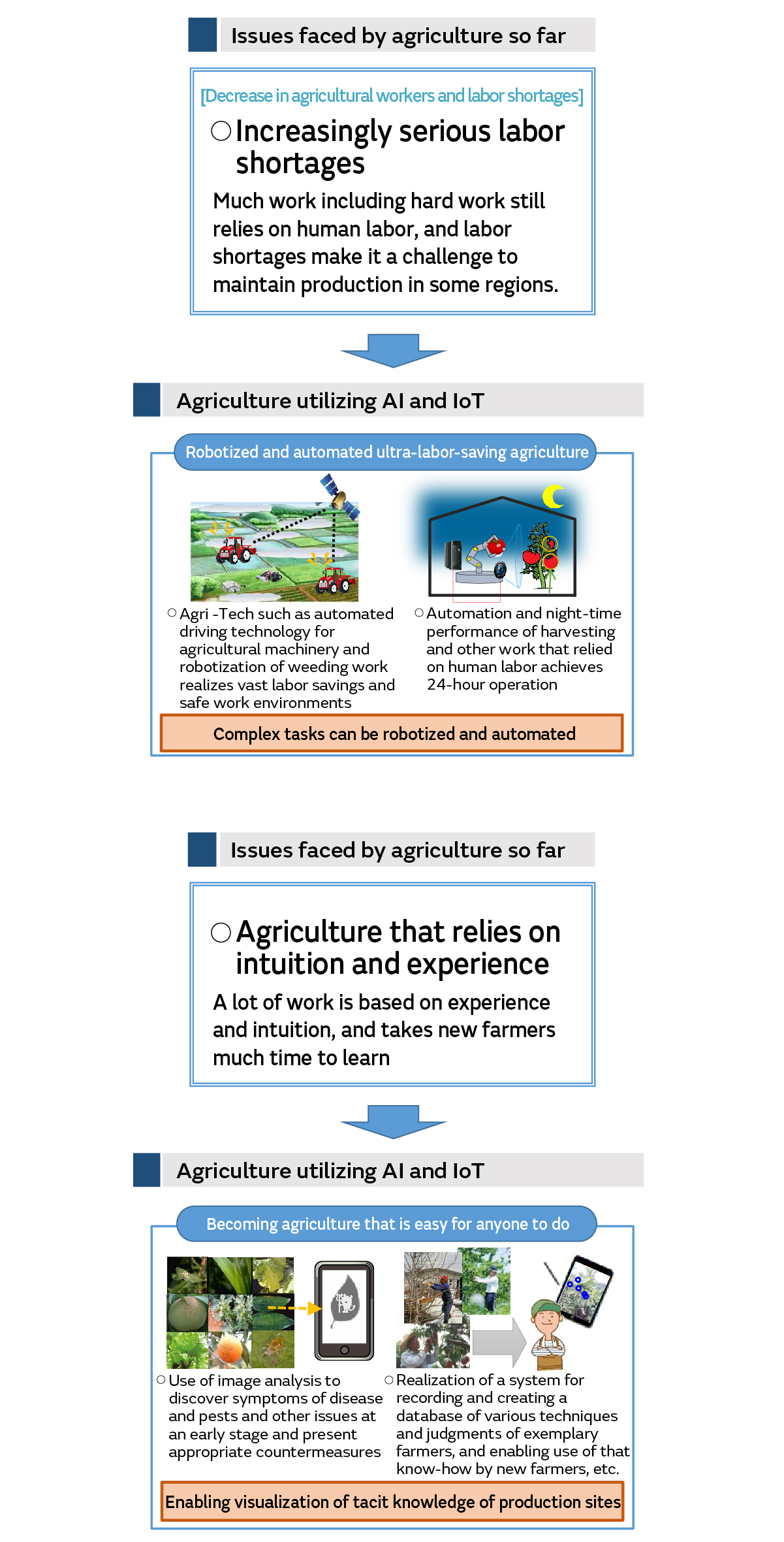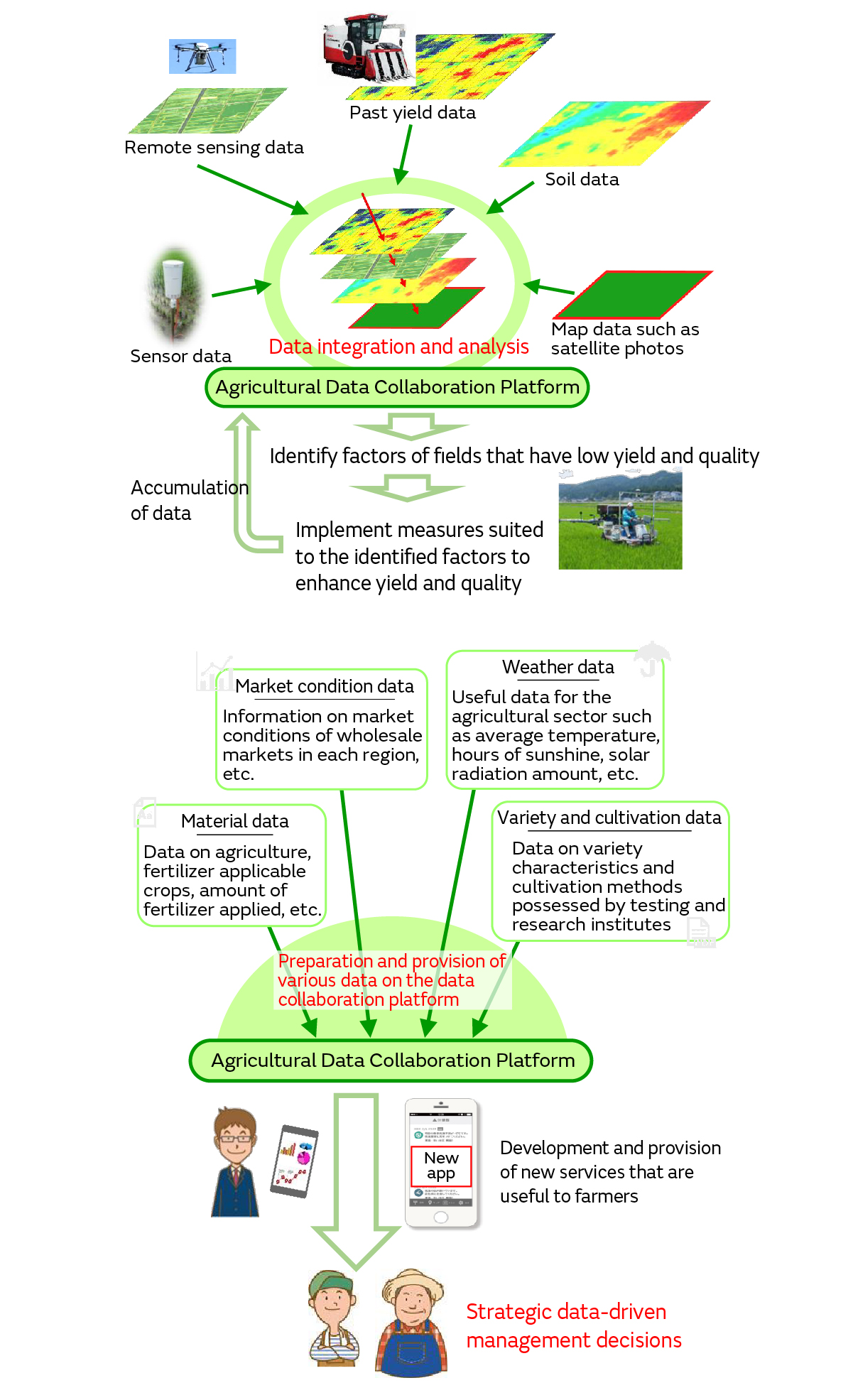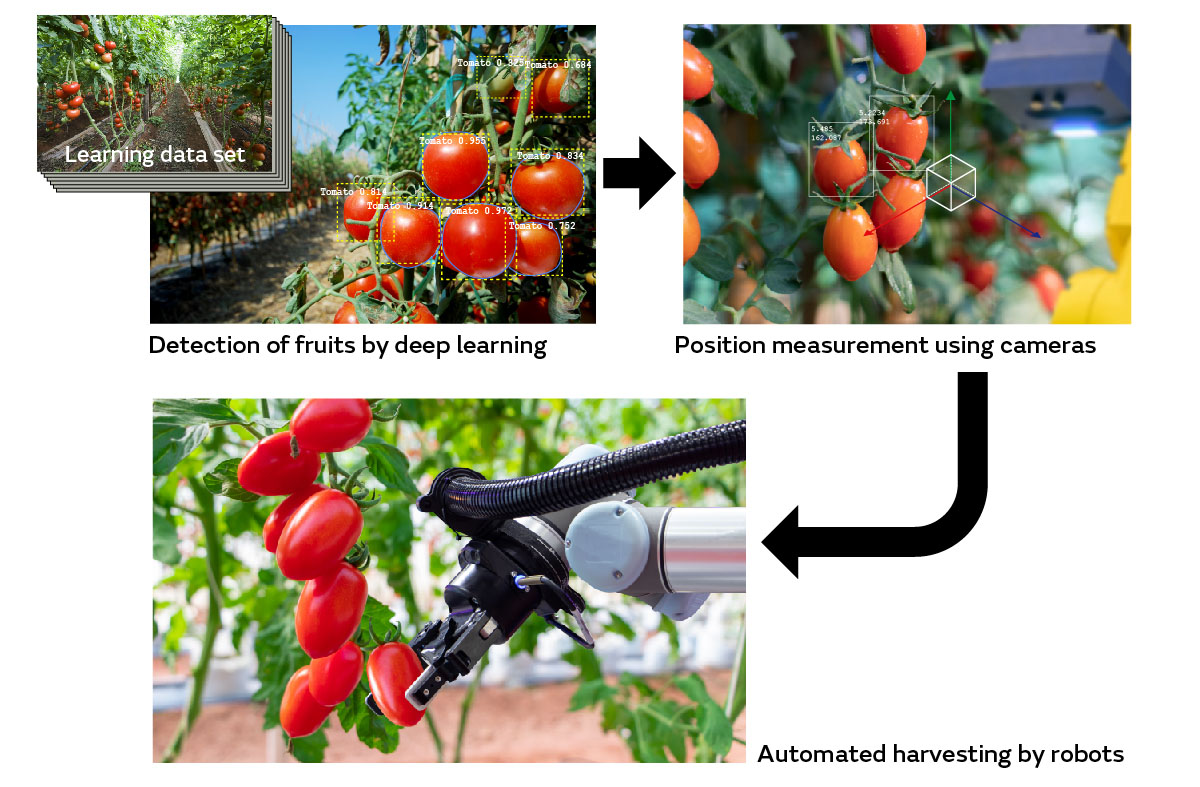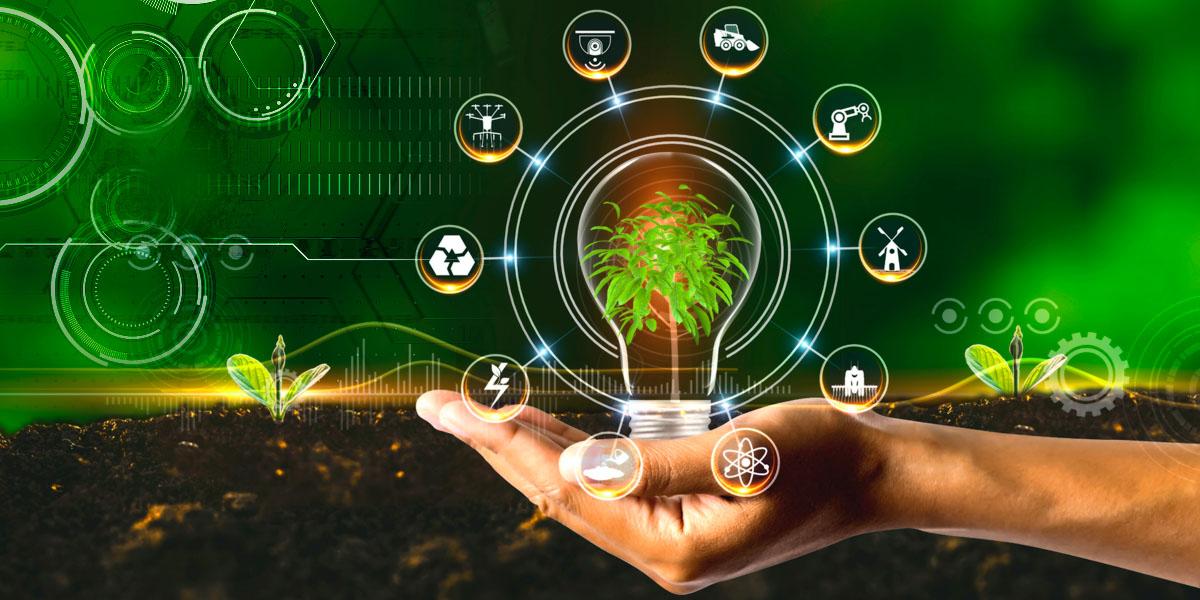Electronic Technology Supporting the Evolution of “Next Tech”
“Agri-Tech” Brings Out the Potential of Land and Crops
Agriculture is an extremely important industry with a long history. However, it tends to be regarded as a mature industry, and some people think that major growth cannot be expected in the future.
However, there is an accelerating movement that aims to revolutionize the agriculture industry by applying the latest technologies such as artificial intelligence (AI), IoT, ICT, robotics, and biotechnology. This article explains this technology development movement called “Agri-Tech” that is bringing new value to agriculture (Fig. 1).

Rational data-driven management of agriculture, which was the domain of experience and skills
Agri-Tech combines the words “agriculture” and “technology.” It seeks to do away with conventional ways of agriculture that rely on personal experience and skills, and promotes rational data-driven judgment and the use of robotics to automate work. For this reason, agriculture that utilizes Agri-Tech is called “smart agriculture.”
Thus far, the use of technology such as selective breeding and the introduction of large agricultural machinery has been gradually promoted in agriculture. However, that progress has been incomparably slow compared with other industries such as electronics and IT. The main reason is that agriculture is an industry where extremely complex and intertwined factors determine the crop yield and quality, which makes it difficult to standardize the work.
Yield and quality vary greatly depending on factors such as the variety and amount planted in the field, the soil components, weather factors such as sunlight and rainfall amounts and water temperature, the impact of disease and pests, and the amount and quality of care. For this reason, exemplary farmers known as “expert rice growers” and others prepare the growing environment by deriving the proper water temperature and level from experience and frequently adding and removing water while examining factors such as the rice field condition, rice growth status, and weather history and forecasts. Yields and crop quality could only be maintained at a high level thus far due to the experience and skills of these farmers.
However, AI and big data analysis technologies have advanced to a level that enables rational, data-driven management of agriculture, which was formerly the domain of experience and skill. In addition, advances in sensors that detect items such as soil components and water levels in rice fields, communication technology such as low-power wide-area (LPWA) communication and 5G, and cloud technology are used to grasp details such as agricultural land conditions and individual crop differences. Furthermore, advances in robotics now enable detailed care without human intervention.
Digitization of the experience and skills of exemplary farmers to address the lack of human resources
Application of Agri-Tech is expected to solve various issues faced by agriculture. The effects of Agri-Tech to address the shortage of agricultural workers, which is a particularly serious issue, are introduced below.
The agriculture industry is on the verge of disappearing in many countries due to the aging of agricultural workers. For example, the agricultural labor force in Japan is just over 1% of the total population*1, and some 70% of agricultural workers are 65 years or older. The introduction of robotic agricultural machinery, which is one type of Agri-Tech, would achieve dramatic labor savings by enabling automated field cultivation, weeding, and harvesting (Fig. 2). It would also enable agricultural work at night, providing the potential for even greater increases in productivity with fewer people.
*1 Ratio of core persons mainly engaged in farming (1,361,000 people) to Japan's total population, as published in the “2020 Census of Agriculture and Forestry” by the Ministry of Agriculture, Forestry and Fisheries. This is a reduction of 22.5% compared with the “2015 Census of Agriculture and Forestry” survey five years earlier.

In addition, if the detailed care of exemplary farmers can be replaced by IoT and their abundant experience can be replaced by big data analysis and AI, even new agricultural workers with little experience will be able to achieve results. The large amount of hard work and long time needed to gain experience in order to achieve proper results are given as reasons why fewer young people are engaged in agriculture. The use of Agri-Tech can transform agriculture into an attractive industry for younger generations where results are determined by rational data-driven decisions.
Some countries are already promoting the use of data in agriculture to take advantage of these benefits. In Japan, the “Agricultural Data Collaboration Platform (WAGRI)” has been constructed as an information platform for the smooth sharing and exchange of various data such as weather, soil, and even crop and agricultural land conditions (Fig. 3). Full-scale operation of WAGRI started from April 2019.

Practicing detailed agriculture with small robot agricultural machinery capable of autonomous work
There is also a growing movement to utilize Agri-Tech to address the shortage of agricultural land. Efficient large-scale agriculture is possible in countries with vast land such as the United States and Australia, but there are also many countries with narrow or irregularly shaped agricultural land where efficiency cannot be enhanced by introducing large agricultural machinery. However, the introduction of small agricultural machinery that can operate autonomously makes it possible to proceed flexibly with work even on narrow agricultural land that is not neatly arranged. This enables the utilization of even small and previously useless land as agricultural land.
As agricultural machinery becomes increasingly robotized, agricultural machinery sizes are expected to decrease. To improve work efficiency, it was previously necessary to introduce large agricultural machinery so that a single operator could handle a wider agricultural land area. However, farmers do not really want to use large agricultural machinery because it is heavy and tramples on fields, adversely affecting crop growth. By using robotic agricultural machines that can operate autonomously, a single person can manage many robots at once, which makes it possible to reduce the machine size and minimize the damage to agricultural land.
Moreover, small robotic agricultural machinery also enables changing the work contents according to the location and the individual crop status while grasping the crop and agricultural land conditions in detail. Technology already being employed is the use of drones to spray pesticides with pinpoint accuracy only in locations where pests have occurred in agricultural land in order to minimize the damage to crops and land. In addition, agricultural robots that apply deep learning to identify only fruits and crops that have reached the harvest timing in good condition and harvest them without damage have also appeared (Fig. 4).

Enabling development of tomatoes that help prevent disease and tearless onions, etc.
Utilization of Agri-Tech also presents the potential for developing agriculture with new value.
For example, advances in genome editing technology, which is a type of biotechnology, have made it possible to efficiently produce innovative varieties that are both delicious and contain high levels of healthy ingredients. Genome editing is a safe technology that is an extension of conventional selective breeding and accelerates the evolution of naturally occurring mutations. It is a completely different technology from genetic modification, which introduces genes of foreign organisms to create organisms that cannot be born in nature. Genome editing makes it possible to produce high-value-added crops, and has already been used to develop crops such as tomatoes that contain high levels of GABA (γ-aminobutyric acid), an ingredient known to prevent high blood pressure and reduce stress, tearless onions, and potatoes that do not contain toxic compounds, etc.
In addition, plant factories that artificially create environments suitable for crop growth and produce vegetables and other crops stably throughout the year without being affected by weather have also been commercialized. There is also an increasingly active movement to carry out urban agriculture in or near consumption areas to locally produce fresh crops for local consumption while minimizing logistics loss. Plant factories realize local production for local consumption, and high-level management of the environment also enables the production of highly functional vegetables with excellent nutritional value. Furthermore, there is also the advantage of being able to grow pesticide-free without the impact of pests, etc.
Agri-Tech has the potential to instantly transform agriculture, which everyone understands is important but may not feel it has a future, into a growth industry. Future growth can be greatly anticipated, including in related industries such as ICT and robots that are associated with Agri-Tech.

